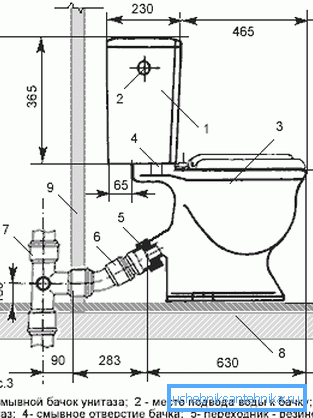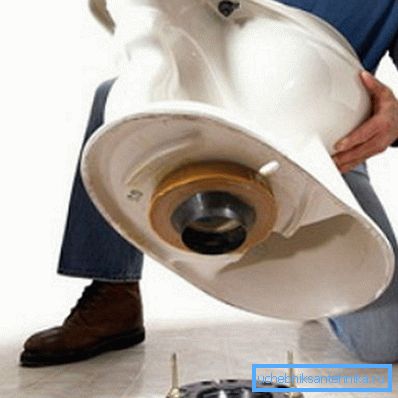How to connect the toilet to the sewage yourself in many
Starting repair in the bathroom, many of us hope to "get off easy fright." However, it turns out far from always, especially if you have to replace the toilet. The lion's share of costs falls on the cost of the products themselves, although connection work can also draw a considerable amount in money. Below we will explain how to avoid them by connecting the sanitary equipment to the sewer system independently.
You should not worry that you never were engaged in sanitary works. It will be enough just to follow the instructions recommended by us.

Ways to connect the toilet to the sewer
In this case, referring to the connection of the device to the drain riser. Usually, its retraction is located close enough to the device itself, so the work will not deliver difficulties.
To connect the sanitary equipment we can use:
- eccentric cuffs;
- corrugated, its price is small, but with it you can make a huge work;
- plastic taps;
- fun pipes.
The latter method is considered the best option. In the end, you get a single plumbing fixture.
However, the use of a fun pipe has some limitations:
- it cannot be shortened;
- It is forbidden to change the geometric shape of the element.
At the same time, the corrugation can be pulled in length and bent at any angle. With its help, it is possible to connect the device in hard-to-reach places, as well as to the drain riser with different receiving sockets.
Eccentric cuffs can be rotated about its axis, so it is possible to compensate for deviations from the alignment of the joined plastic pipes.

Use corrugation
Below is the instruction of the order of work:
- Lubricate one end of the corrugations with silicone and insert it into the sewer socket.
- Connect the other end to the toilet.
- Check the reliability of the joint by pouring a bucket of water into the plumbing fixture. If there are no leaks, then the connection is secure.
- Mark the places for fixing the device to the floor. Disconnect the corrugation for a while from it and set the device aside. Drill the holes for the dowels, put the device in place and attach it.
- Coat the corrugation with sealer sealant and connect it to the toilet. Check for loose connections.

Apply a fun pipe or adapter
In this case, we will not use a corrugation. There are three ways to connect the sanitary equipment to the adapter:
| Oblique | This method was widely used in apartments commissioned since 1960 (late Stalin, Khrushchev, Brezhnev), in private houses and dormitories of that period. So do not be surprised if you buy a house built in the 60-80s of the twentieth century, the toilet will have a slanting release. |
| Vertical | This connection option is older than the previous one. Such projects were carried out in the "Stalin" of the 30-60s of the 20th century.
In this case, the sewage system will be placed under the floor, which will allow to add free space in the bathroom. |
| Horizontal | The first such models in our country appeared from abroad. Since the corrugation was not yet, the connection was problematic. After some time, the problem was successfully resolved. The modern sanitary fixture with horizontal release is bought in two cases:
At the same time, the drainage riser is open, so it is hidden in the wall - behind a decorative false panel or in a prepared strobe. We do not recommend hiding the sewer pipe too securely, the best option is a collapsible panel. Although rare, communications will have to be cleaned, repaired or replaced. |

Tip: when choosing a toilet bowl, make sure that its release exactly matches the release of the drain network. Otherwise, you must use a curved adapter pipe.
How to connect to the waste system toilet with a vertical release:
- Try on the plumbing fixture and mark it on the floor.
- Install a standard screw flange fitted with a retainer.
- A sewage pipe should enter the round hole in the center of the flange.
- Put the toilet in such a way that the cuff of the flange exactly fits into the socket of its vertical release. Rotate the spigot until you secure it.

Connecting the toilet with a horizontal release
In this case, the sewer riser is located at the back wall of the bathroom. At the toilet outlet is directed back, so to connect the outlet with a drain pipe using a special sealing cuff or corrugation.
Work plan:
- Put the toilet on the floor and make a markup.
- When the issue of sanitary fixtures completely coincides with the sewer drain, use the seal sleeve. If a discrepancy is found, for example, a vertical or horizontal displacement, then use a corrugation.
- Try on the sealing lip or corrugation without using a sealant. Check for leaks, just click on the drain and watch.
- If there is no leak, treat the ends of the shaped part with a sealant and connect the toilet to the riser.
- Screw the unit to the floor.

Tip: Do not lean too much on the tools so as not to damage the product.
We connect to the sewer toilet with oblique release
Prepare:
- drying oil;
- red lead;
- resin hemp strand;
- sealing cuff;
- sealant.

Process:
- Lubricate the appliance's release along with the grooves with a mixture of varnish and red lead.
- Wind the resin strand, leaving 5 mm free. Treat it with red lead.
- Connect the toilet, make sure that its release fell into the socket of the sewer pipe.
- You can make an oblique connection and using a sealing cuff. Put it on the release and lower it into the socket of the sewer. In this case, be sure to use a sealant.
Connection to the cast iron pipe
- The most common option is - lowering the release of the toilet into the socket sewer. The remaining gap is smeared with cement mortar.
Watch out: so that the solution does not get into the riser.
- It is also useful to have a rubber cuff that needs to be put on the release, which then needs to be dipped into the socket of the pipe. Before this, it must be thoroughly cleaned from various debris and sediments. We also recommend using a sealant to prevent odors from entering the home.

- Use corrugation, if plumbing device is turned to the socket at an angle or extended. In this case, you will have a small counter slope, in which water will constantly accumulate.
- Use a corrugation even when after repair the toilet on the tile will stand too high, which will not allow the release to enter the socket.
Conclusion
A bathroom in any home is a special place, so all elements and devices in it must be installed correctly. In this case, you have learned how to connect a toilet that has an oblique, vertical or horizontal outlet to the drain.
Each of the methods differs from the others in its peculiarity, however, the main goal is the same - to make the connection tight. To do this, use a variety of materials objects, including, corrugation, sealant, cuff. The video in this article will provide an opportunity to find additional information on the above topic.